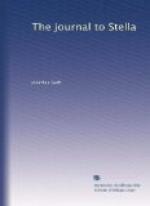19 Charles Scarborow and Sir William Foster were the Clerks of the Board of Green Cloth.
20 See Letter 27, note 16 on Thomas Coke.
21 The Earl of Sunderland’s second wife, Lady Anne Churchill, who died in 1716, aged twenty-eight. She was the favourite daughter of the Duke of Marlborough, and was called “the little Whig.” Verses were written in honour of her beauty and talent by Charles Montagu, Earl of Halifax, Dr. Watts and others, and her portrait was painted by Lely and Kneller.
22 Mary, daughter of Sir William Forester, of Dothill, Shropshire. In 1700, at the age of thirteen, she had been secretly married to her cousin, George Downing, a lad of fifteen. Three years later, Downing, on his return from abroad, refused to acknowledge his wife, and in 1715 both parties petitioned the House of Lords for leave to bring in a Bill declaring the marriage to be void; but leave was refused (Lords’ Journals, xx. 41, 45). Downing had become Sir George Downing, Bart., in 1711, and had been elected M.P. for Dunwich; he died without issue in 1749, and was the founder of Downing College, Cambridge.
23 In a discussion upon what would be the result if beards became the fashion, Budgell (Spectator, No. 331) says, “Besides, we are not certain that the ladies would not come into the mode, when they take the air on horseback. They already appear in hats and feathers, coats and periwigs.”
Letter 28.
1 Horse-racing was much encouraged by Charles ii., who, as Strutt tells us, appointed races to be made in Datchet Mead, when he was residing at Windsor. By Queen Anne’s time horse-racing was becoming a regular institution: see Spectator, No. 173.
2 John Montagu, second Duke of Montagu, married Lady Mary Churchill, youngest daughter of the Duke of Marlborough.
3 Of Clogher.
4 John Adams, Prebendary of Canterbury and Canon of Windsor. He was made Provost of King’s College, Cambridge, in 1712, and died in 1720.
5 The Hon. and Rev. George Verney, Canon of Windsor (died 1728), became fourth Lord Willoughby de Broke on the death of his father (Sir Richard Verney, the third Baron), in July 1711. Lord Willoughby became Dean of Windsor in 1713.
6 Thomas Hare, Under Secretary of State in Bolingbroke’s office.
7 Richard Sutton was the second son of Robert Sutton, the nephew of the Robert Sutton who was created Viscount Lexington by Charles I. Sutton served under William iii. and Marlborough in Flanders, and was made a Brigadier-General in 1710, in which year also he was elected M.P. for Newark. In 1711 he was appointed Governor of Hull, and he died, a Lieutenant-General, in 1737 (Dalton’s Army Lists, iii. 153)
8 Charles Seymour, sixth Duke of Somerset (1662-1748), known as “the proud Duke of Somerset.” Through the influence which his wife—afterwards Mistress of the Robes (see Letter 17, note 10)—had obtained over the Queen, he bore no small part in bringing about the changes of 1710. His intrigues during this period were, however, mainly actuated by jealousy of Marlborough, and he had really no sympathies with the Tories. His intrigues with the Whigs caused the utmost alarm to St. John and to Swift.




